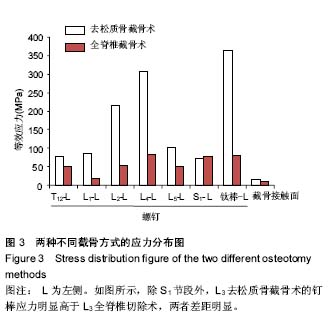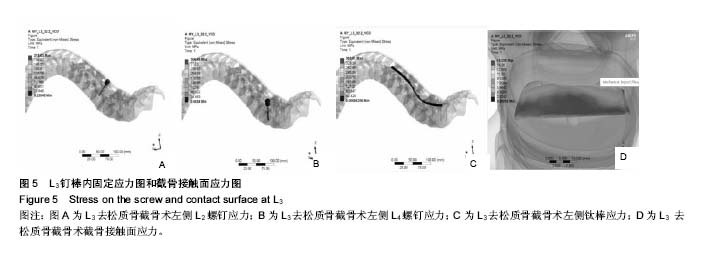| [1] 赵丽珂,黄慈波.强直性脊柱炎的诊断治疗进展[J]. 临床药物治疗杂志, 2010, 8(1): 14-18.[2] 曾岩,陈仲强,郭昭庆,等.强直性脊柱炎后凸畸形的后路截骨矫形术及疗效分析[J].中华外科杂志, 2010, 48(16):1234-1237.[3] 齐鹏,宋凯,张永刚,等.单节段脊柱去松质骨截骨与双节段经椎弓根截骨矫正强直性脊柱炎后凸畸形的临床效果比较[J]. 中国脊柱脊髓杂志,2015, 25(9): 775-780.[4] 郑国权,王岩,王景明,等.后路脊柱去松质骨截骨治疗Pott′ s角状后凸畸形的安全性及有效性[J]. 中国脊柱脊髓杂志,2016, 26(1): 18-23.[5] 齐鹏,宋凯,张永刚,等.强直性脊柱炎后凸畸形个性化矫形对术后生活质量影响的相关分析[J]. 中国骨与关节杂志,2015,14(8): 639-943.[6] 金海明,王向阳.脊柱矢状面畸形截骨角度计算方法的研究进展[J].中华骨科杂志, 2016, 36(5): 298-306.[7] Behari S, Tungeria A, Jaiswal AK, et al. The" moustache" sign: Localized intervertebral disc fibrosis and panligamentous ossification in ankylosing spondylitis with kyphosis. Neurol India. 2010;58(5): 764.[8] Burstein AH, Reilly DT, Martens M. Aging of bone tissue: mechanical properties. J Bone Joint Surg Am. 1976;58(1): 82-86. [9] Shirazi-adl SA, Shrivastava SC, Ahmed AM. Stress Analysis of the Lumbar Disc-Body Unit in Compression A Three-Dimensional Nonlinear Finite Element Study. Spine. 1984;9(2): 120-134.[10] 管明强.强直性脊柱炎诊疗现状的临床研究[D]. 广州:南方医科大学, 2014.[11] 叶文芳,刘健,曹云祥,等.强直性脊柱炎患者心功能,肺功能及骨代谢变化的研究进展[J]. 风湿病与关节炎, 2014, 3(8): 46-48.[12] 付君. 经椎弓根椎体截骨术治疗强直性脊柱炎后凸畸形患者术后心肺功能改变的研究[D]. 中国人民解放军总医院, 解放军医学院, 解放军总医院, 军医进修学院, 2015.[13] 徐飞,吕永明,宋莺春,等.全髋关节置换修复强直性脊柱炎: 脊柱-骨盆矢状面平衡及生活质量变化[J]. 中国组织工程研究, 2015,19(4): 516-521.[14] 钱邦平,胡俊,邱勇,等.强直性脊柱炎胸腰椎后凸畸形患者生存质量与矢状面参数的相关性[J].中华骨科杂志, 2014, 34(9): 895-902.[15] Wang Y, Zhang YG, Zheng GQ, et al. [Vertebral column decancellation for the management of rigid scoliosis: the effectiveness and safety analysis]. Zhonghua wai ke za zhi. 2010;48(22): 1701-1704.[16] 刘新宇,原所茂,田永昊,等. 扩大“蛋壳”结合闭合-张开技术治疗胸腰椎角状后凸畸形[J]. 中国脊柱脊髓杂志, 2014, 24(9): 779-783.[17] 张永刚,王岩,张雪松,等.扩大蛋壳技术单纯后路切除青少年胸腰段半脊椎[J]. 脊柱外科杂志,2007,5(2): 69-72.[18] Suk SI, Kim JH, Kim WJ, et al. Posterior vertebral column resection for severe spinal deformities. Spine. 2002;27(21): 2374-2382.[19] Obeid I, Bourghli A, Boissière L, et al. Complex osteotomies vertebral column resection and decancellation. Eur J Orthop Surg Traumatol. 2014;24(1): 49-57.[20] Shirazi-Adl A, Ahmed AM, Shrivastava SC. A finite element study of a lumbar motion segment subjected to pure sagittal plane moments. J Biomech. 1986;19(4):331-350.[21] 王景丰.探讨强直性脊柱炎早期临床特点,早期诊断,治疗及预后[D].天津医科大学, 2012. [22] 赵志明,姚子明,郑国权,等. 强直性脊柱炎胸腰段后凸矫形手术近端固定椎的选择[J]. 中国脊柱脊髓杂志,2016, 26(10): 886-892. [23] 姚子明,郑国权,王征,等.强直性脊柱炎后凸畸形手术相关研究进展[J]. 中国脊柱脊髓杂志, 2016, 26(2):176-181. [24] 汪飞,邱勇,钱邦平,等.后路全脊椎截骨治疗严重脊柱畸形内固定棒断裂危险因素分析[J].中华骨科杂志, 2012, 32(10): 946-950.[25] 杨全中,张雪松,杨晓清,等. 脊柱后路去松质骨截骨术用于脊柱畸形翻修手术的安全性和有效性[J]. 中国脊柱脊髓杂志, 2016, 26(8): 715-722.[26] Pavan PG, Pachera P, Forestiero A, et al. Investigation of interaction phenomena between crural fascia and muscles by using a three-dimensional numerical model. Under Revision at J Biomech. Cerca con Google, 2015. [27] Alam K, Mitrofanov AV, Silberschmidt VV. Thermal analysis of orthogonal cutting of cortical bone using finite element simulations. Int J Exp Comput Biomech. 2010;1(3):236-251. [28] 田勇,王阳,夏长丽,等.鹿,羊和人腰椎形态计量学关联性分析[J]. 吉林大学学报:医学版, 2010, (1):163-168. [29] 赵金柱,袁伟,徐卫东. 脊柱关节炎动物模型的研究现状[J]. 中国骨与关节外科, 2015,8(2):173-176. [30] 熊洋,俞兴.腰椎棘突间撑开装置生物力学及有限元分析的研究与进展[J].中国组织工程研究, 2016, 20(39):5919-5928. [31] 宋凯,张永刚,付君,等. 脊柱矫形对强直性脊柱炎胸腰段后凸畸形患者髋关节相关活动能力及生活质量的影响[J]. 中国脊柱脊髓杂志, 2015, 25(10): 871-882.[32] 朱泽章,邱勇.强直性脊柱炎胸腰椎后凸畸形矫正的术式选择[J]. 中国矫形外科杂志, 2004,12(1): 122-123.[33] 初同伟,刘玉刚,钱奕铭,等. 经后路椎间盘椎弓根间截骨矫正胸腰段脊柱后凸畸形[J].中华创伤杂志, 2011,27(6): 513-516.[34] 李危石,孙卓然,陈仲强. 正常脊柱-骨盆矢状位参数的影像学研究[J]. 中华骨科杂志,2013, 33(5): 447-453.[35] 史亚民.全脊椎截骨或切除术矫治脊柱侧后凸畸形的相关问题探讨全脊椎截骨术的适应证及手术注意事项[J]. 中国脊柱脊髓杂志,2007,17(4): 250-251.[36] 张利强,初同伟,赵光荣. 脊柱去松质骨化截骨术治疗强直性脊柱炎并脊柱后凸畸形的疗效分析[J]. 中国临床研究, 2015, 28(5): 579-581.[37] 马俊毅,杨静,马原,等.螺钉置入修复强直性脊柱炎并发重度车轮状后凸畸形:应力分布于多节段[J]. 中国组织工程研究, 2015,19(13): 2069-2074.[38] 刘辉,郑召民,李思贝,等.脊柱-骨盆曲线和谐角在脊柱畸形矢状面评价中的应用[J].中华骨科杂志, 2014, 34(8): 831-838.[39] 钱邦平,邱勇,潘涛,等. 经椎弓根不对称截骨重建强直性脊柱炎胸腰椎侧后凸畸形患者双平面平衡[J]. 中华骨科杂志, 2015, 35(4): 341-348.[40] 邱勇. 重视成人脊柱畸形矫形中脊柱-骨盆矢状面平衡的重建[J]. 中国脊柱脊髓杂志, 2012, 22(3): 193-195. |
.jpg)




.jpg)
.jpg)
.jpg)
.jpg)